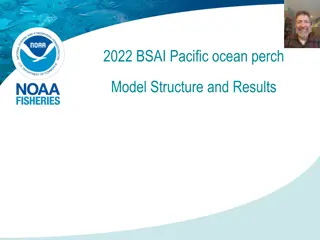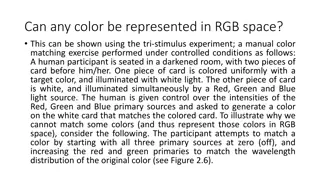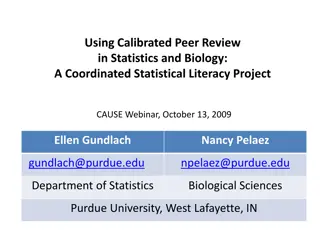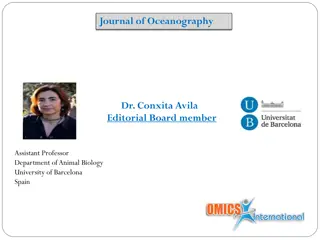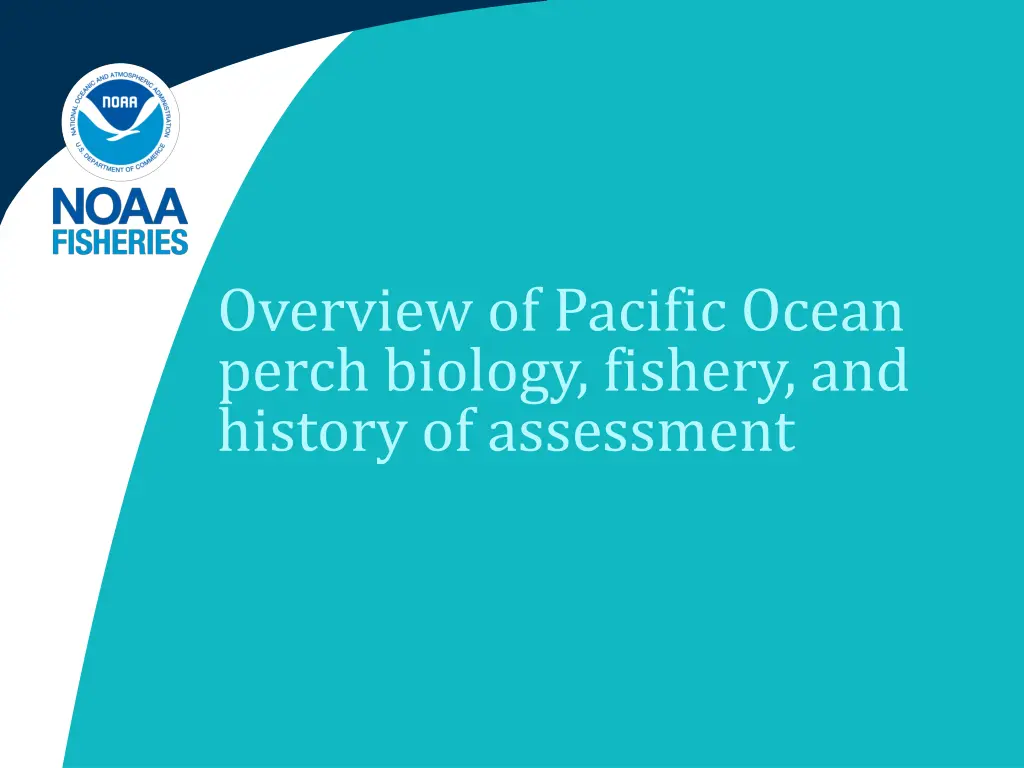
Insight into Pacific Ocean Perch Biology, Fishery, and Assessment History
Explore the biology, fishery, and assessment history of Pacific Ocean perch, a slow-growing species with unique reproductive characteristics. From distribution to predators, delve into key aspects of this fascinating fish.
Download Presentation

Please find below an Image/Link to download the presentation.
The content on the website is provided AS IS for your information and personal use only. It may not be sold, licensed, or shared on other websites without obtaining consent from the author. If you encounter any issues during the download, it is possible that the publisher has removed the file from their server.
You are allowed to download the files provided on this website for personal or commercial use, subject to the condition that they are used lawfully. All files are the property of their respective owners.
The content on the website is provided AS IS for your information and personal use only. It may not be sold, licensed, or shared on other websites without obtaining consent from the author.
E N D
Presentation Transcript
Overview of Pacific Ocean perch biology, fishery, and history of assessment
POP Distribution Sebastes alutus Range: Japan to California Source: aquamaps.org - Most abundant rockfish in BSAI - Offshore 150-420 m - Adults predominantly offshore in depths of 200 300 m (Chikuni1975) occupy deeper depths during the winter months (Westrheim 1970). - Patchy, localized aggregations (Hanselman et al. 2001) - Semi-demersal (can have pelagic component) Page 2 U.S. Department of Commerce | National Oceanic and Atmospheric Administration | National Marine Fisheries Service
POP Biology Slow growing (max age 104 in BSAI) Maturity A50 ~ 8.4 10.5 years Live-bearing: internal fertilization; give birth to a large number of planktonic larvae (Kendall and Lenarz 1987) Fecundity: 10,000 300,000 larvae True viviparity: embryos receive some additional maternal nutrition beyond what is provided from the yolk during gestation (Boehlert et al. 1987) Page 3 U.S. Department of Commerce | National Oceanic and Atmospheric Administration | National Marine Fisheries Service
POP Biology Insemination in fall, fertilization ~ 2 mo later Eggs hatch internally, parturition April/May Planktonic larvae (pelagic high recruitment variability) Difficult to ID Pelagic post-larval/early YOY stage Settle inshore in high relief, rocky areas Begin migration to deeper waters ~ age-3 Continue to migrate deeper reach adulthood on continental slope Adults and juveniles spatially separate (Carlson and Straty 1981; Rooper et al. 2007) Page 4 U.S. Department of Commerce | National Oceanic and Atmospheric Administration | National Marine Fisheries Service
POP Prey & Predators Limited observations -- rockfish are generally not observed frequently in the stomach samples Predominately planktivorous Euphausiids, copepods, some myctophids Similar diet to walleye pollock Juvenile predators: seabirds, rockfish, salmon, lingcod, large demersal fish Adult predators: sablefish, Pacific halibut, sperm whales Page 5 U.S. Department of Commerce | National Oceanic and Atmospheric Administration | National Marine Fisheries Service
POP Fishery Large foreign trawl fishery in the BSAI began in early 1960s Aleutian Islands peak catches in 1965 (109,000 t) Catches declined in late 1960s and through the 1970s Domestic trawl fleet began in 1986 Fully domestic fishery began in 1990 Fishery conducted by large trawlers and factory processers Page 6 U.S. Department of Commerce | National Oceanic and Atmospheric Administration | National Marine Fisheries Service
NMFS Areas 508 509 512 513 514 516 140o W. Longitude 517 518 519 521 523 524 Eastern Bering Sea Western Aleutians Central Aleutians Eastern Aleutians Western GOA Central GOA Eastern GOA 550 630 649 650 659 670 710 720 730 740 Bering Sea Juneau
BSAI POP Management History Late 1970s -- first NMFS slope surveys Pre-1991 Managed with the POP complex (along with 4 other species of red rockfish) 1988 Specification of ABCs for the EBS and AI 1991 Created other red rockfish to separate POP 1992 Specification of OFLs for the EBS and AI Prior to 2001, EBS and AI POP were assessed and managed as separate stocks. Beginning in 2001, the two areas were combined in a single management unit Subarea ABCs and TACs in the AI were adopted in 1996 due to disproportionate harvesting in the eastern AI Amendment 80 implemented in 2008, focused on non-pollock vessels, with goals of increasing retention, creating cooperatives, and allocating harvest among cooperatives. Resulted in less temporal concentration of catch within the year. Page 8 U.S. Department of Commerce | National Oceanic and Atmospheric Administration | National Marine Fisheries Service
Management: POP Assessment Stock assessment authors prepare SAFE report Recommend Acceptable Biological Catch (ABC) ABC Incorporated stock dynamics & ecological uncertainty Fishery and survey data and modeling Partitioned by Area Reviewed by Council Committees The SSC approved ABC cannot be increased by the Council Also sets a Total Annual Catch (TAC) TAC <= ABC TAC incorporates social and economic factors and management uncertainty Page 9 U.S. Department of Commerce | National Oceanic and Atmospheric Administration | National Marine Fisheries Service
Management: NPFMC control rules Tier 1: B, BMSY, and pdf of FMSY Tier 2: B, BMSY, FMSY, F35%, F40% Tier 3: B, B40%, F35%, and F40% Stock status relative to B40% Tier 4: B, F35%, and F40% FOFL = F35%; FABC <= F40% Tier 5: B and M FOFL = M; FABC = 0.75M Tier 6: Catch history 1978 1995 Page 10 U.S. Department of Commerce | National Oceanic and Atmospheric Administration | National Marine Fisheries Service
NPFMC Tier 3 HCR Page 11 U.S. Department of Commerce | National Oceanic and Atmospheric Administration | National Marine Fisheries Service
POP In-season Management Goal: Do not exceed TAC Considers incidental catch in other fisheries If TAC reached retention prohibited If ABC reached closures occur Exceeding ABC is uncommon, exceeding OFL is rare Observer program for monitoring catch Closures for prohibited species bycatch Pacific halibut, king crab, salmon Page 12 U.S. Department of Commerce | National Oceanic and Atmospheric Administration | National Marine Fisheries Service
Previous CIE Notes - 2013 Exploration of trawl survey data to better understand spatial aggregations (zero-inflated models, GAMs, GLMs) Field and modeling work on trawlable/untrawlable habitats continue, although largely focused in the Gulf of Alaska Exploration of key parameter estimates (natural mortality, maturity) Maturity-at-age is modeled with the logistic function conditionally within the assessment by fitting two datasets (2004, 2010). Parameters for the logistic function describing maturity-at-age are estimated within the model so that uncertainty in model results (e.g., ABC) can be linked to uncertainty in maturity parameter estimates. The prior for natural mortality has been obtained values from the current literature, and natural mortality will be explored further in this review Exploration of fishery selectivity Bicubic splines are used to model time-varying fishery selectivity. Page 13 U.S. Department of Commerce | National Oceanic and Atmospheric Administration | National Marine Fisheries Service
Previous CIE Notes - 2013 Exploration of ageing error matrix and plus group In 2014 an extended ageing error matrix was implemented into the POP assessment in order to improve the fit to the plus age group and adjacent age classes Exploration of stock-recruitment relationship A defined stock-recruitment relationship has not yet been discovered for this, or the majority of stocks assessed by AFSC. Inclusion of model diagnostics and sensitivity analyses Retrospective performance has become a standard model diagnostic presented in our stock assessments. Sensitivity analyses are not included in assessments formally but are presented when highlighting issues or are used for model comparison/selection. Additional diagnostics are explored in this review. Match spatial scale of stock dynamics to management scale This is more of an issue for BSAI rockfish stocks other than POP Page 14 U.S. Department of Commerce | National Oceanic and Atmospheric Administration | National Marine Fisheries Service









